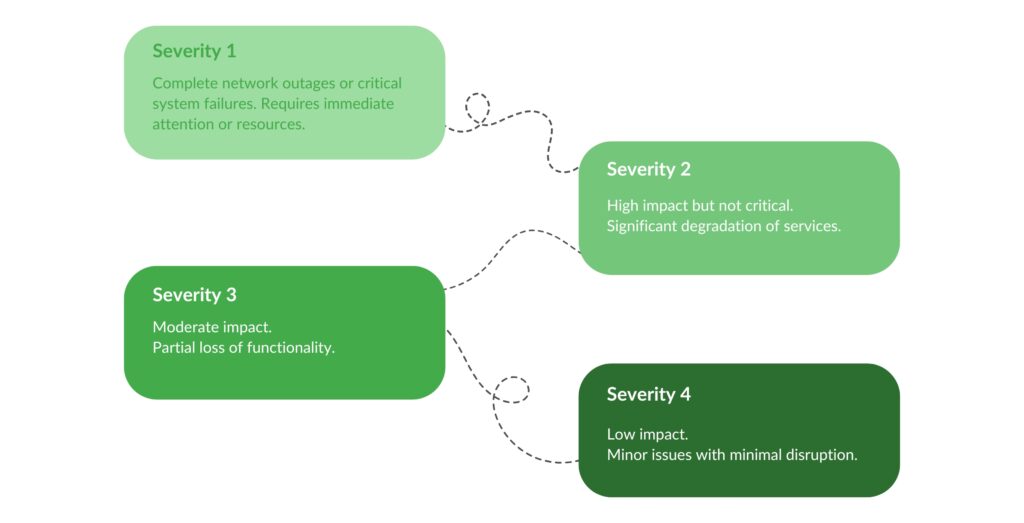Introduction
In this month’s webinar, Ryan Harris, our Director of Service Delivery, defines the different incident severity levels and their impacts on your network. He shares best practices for responding to and remediating Severity 1 Incidents, the most critical incidents in networking.
What Are Incident Severity Levels?
Incident severity levels categorize the impact and urgency of incidents. The impact of an incident is who or what is affected by the incident, including people, resources, and systems. Urgency is the extent of damage that could occur if the issue is not promptly resolved.
There are four severity levels:

Examples of Severity Level Incidents
Severity 1: The network goes down at a corporate location housing 1,500 users.
Severity 2: A company has one large corporate location with ten satellite locations and one of its satellite locations has a network outage.
Severity 3: An application that is only used by certain members of a business is non-functional.
Severity 4: One access point in a corporate location is not functioning.
What are Severity 1 Incidents?
Severity 1 Incidents are the most critical type of incidents in networking. They represent situations with a complete or significant disruption of services that affects the entire organization or most users.
These incidents can take several forms:
Complete Network Outage: An organization’s entire network is down, affecting all users and services.
Critical System Failure: Essential systems or applications are non-functional, halting business operations.
Security Breach: A major security incident that compromises sensitive data or systems.
High Financial Impact: Incidents that can lead to significant financial losses or legal repercussions.
How to Respond to Severity 1 Incidents
Because Severity 1 Incidents are the most detrimental to your business, you should be prepared and informed about how to respond to them.
Immediate Escalation: Severity 1 Incidents require immediate attention and should be escalated to the highest technical support and management level.
Dedicated Resources: Ensure that a dedicated team is available to respond to Severity 1 incidents around the clock. This should include technical AND management resources when possible.
Communication: Maintain clear and constant communication with all stakeholders, including updates on the incident status and expected resolution times.
How to Fix Severity 1 Incidents
After appropriately responding to a Severity 1 Incident, it’s time to focus on mending the issue to restore order to your business. While incidents may impact your business differently, you should use the same remediation process each time.
Rapid Mitigation: Implement temporary fixes to restore services as quickly as possible while working on a permanent solution.
Focused Efforts: Keep technical resources working in a stepwise fashion to isolate symptoms as efficiently as possible while also working to rule out potential incident causes.
Provide ‘Air Cover’: Management resources should provide ‘air cover’ or run interference for engaged technical resources to avoid distractions.
Conducting an Impact Assessment
An impact assessment evaluates the potential consequences of an incident on business operations. These may include revenue loss, customer dissatisfaction, operational disruption, and reputational damage.
Steps to Assess Impact:
- Identify Affected Systems and Services: Determine which systems, applications, and services are impacted by the incident and assess the scope of the impact.
- Evaluate the Extent of Disruption: Measure the level of disruption to business operations. Consider factors like the number of users affected and the duration of the outage.
- Estimate Potential Financial and Operational Impacts: Calculate potential revenue losses caused by downtime. Assess the impact on productivity and operational efficiency. Consider any costs that might be associated with legality or compliance.
Conclusion
Network incidents can have critical impacts on your business and its operations. To minimize an incident’s impact on your business, you should develop a clear framework, regularly review and update criteria, and use incident management tools to automate and streamline the prioritization process.
Don’t wait for an incident to improve your organization’s network. Learn how Plow Networks can transform your business with tailored services to match your needs: Explore Our Network Services.



